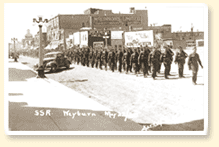

The South Saskatchewan Regiment parades in Weyburn, Sask., May 22, 1940. |
The war changed Canada. It became a rich industrial nation producing
aircraft, ships, weapons, vehicles, and food not only for the
national war effort but also for the country's .
The state stepped into the lives of Canadians as never before, and those in
government thought seriously about a system of benefits - a welfare
state - to ensure the health and wellbeing of all citizens. The
world, too, looked a different place now, and not necessarily a
safer place, and at war's end Canadians looked outwards to
co-operation with other countries for peace and security. Canada did
not like Britain any less, and particularly admired its heroic
struggle under Winston Churchill, but British power was declining.
Canadians now thought of the United States as their best friend and
main protector. Canada's military contribution to the war was more varied than in
the First World War, and was strong everywhere, on the land and sea
and in the air. In Canada it included the cross-country British
Commonwealth Air Training Plan (BCATP) and naval, military and air
operations in North America against German in the Gulf of
St. Lawrence and the Japanese invasion of the Aleutian island chain.
Overseas, Canadians fought in the Battle of the Atlantic, the bombing campaign over German cities and the freeing of western
Europe from German occupation. In the Hamilton Spectator and other newspapers represented in this
collection, the war was seen as a struggle to save Britain, the
mother country of so many Canadians, from being wiped off the map.
That meant, for urban eastern Canadians, the making of every
necessary sacrifice to win the war. Many Canadians elsewhere were
just as committed to victory, but concerned about keeping the
country together as well. The main dividing point, as in the First
World War, came over conscription, or compulsory military service.
The cry for conscription from people like those who read the
Spectator, and the opposition to it from francophone Quebec and in
parts of western Canada, tested every one of the skills of Prime
Minister Mackenzie King, the supreme juggler of Canadian politics.
The greatest achievement of a long political career was keeping
Canada united in the Second World War. Related Newspaper Articles
English Articles
|